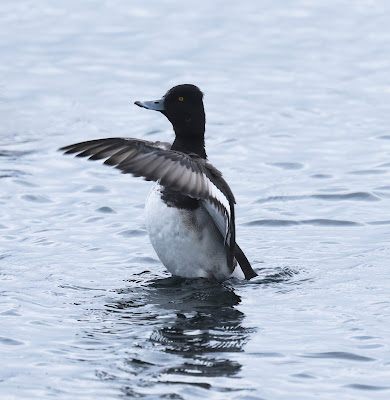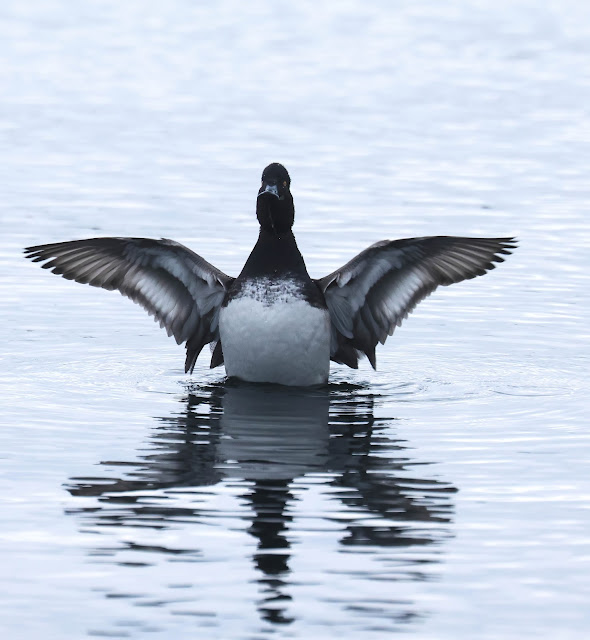My good friend Clackers has been going through the emotional wringer these last months and to help him back to his normal self I suggested a trip to Slimbridge WWT on Friday. It would be just like former times when the two of us went on various sorties to see birds both near and far and before unforeseen events put a stop to our outings
Farmoor Reservoir has been in the birding doldrums these last two months but late on Thursday afternoon news came through of an upturn in fortune with a 'probable' drake Lesser Scaup being found on the reservoir. It was too late to get there by the time I got the news so I was presented with a dilemna for both myself and Clackers .........
Now for a slight digression.
This was only the fifth record of a Lesser Scaup to be found in the county.The last was a first winter drake found as long ago as the 30th December 2007 at Sutton Courtenay. Officially there have been only four records as the British Birds Record Committee (BBRC), wrongly in my opinion, rejected a perfectly good record of a first winter female found in March 2000 at Thames Water's Pinkhill Reserve which is an integral part of Farmoor Reservoir. The reason for its rejection was that no images of the diagnostic upperwing bar pattern were obtained. This bird was accepted by many of us Oxonbirders as the first for Farmoor Reservoir thus making the subsequent current star of the show, the second if you ignore the BBRC verdict, which I do.
A male that looked very like the real thing also frequented the reservoir in the winter of 2017 and returned to winter in both 2018 and 2019. It was soon ruled out as being a hybrid Greater Scaup x Lesser Scaup, as when it spread its wings they showed the bar of white on the secondaries extending onto the primaries. A genuine Lesser Scaup should only show white on the secondaries (inner wing) and none on the primaries (outer wing)
Now back to my tale
Farmoor Reservoir is our local patch, neither of us had ever seen a Lesser Scaup there and indeed, as explained above, they are a very rare bird in Oxfordshire so this was an opportunity categorically not to be missed by either of us
I called Clackers that evening and suggested a change of plan and we go to Farmoor Reservoir first thing when the gates opened at 8am on Friday and if we saw the duck quickly then go on to Slimbridge as planned. This was agreed and so it was we arrived at the reservoir on a cold and grey Friday morning.
The duck was at the far end of the reservoir causeway - keeping up the grand tradition of Farmoor where rare birds invariably gravitate to that end of the central causeway. Clackers has a special pass to allow him to drive round the reservoir's perimeter track so we availed ourselves of this privilege and drove round to the far end where we found the scaup with a small group of Tufted Ducks. We watched it for around five minutes before it flew off with two Tufted Ducks.When it flew I took a quick record photo of it (see below) which clearly showed the diagnostic wing pattern of a Lesser Scaup where the white on the wing bar is only present on the inner wing.
Satisfied we made our way to Slimbridge WWT and had a really good and enjoyable day, notching up another American rarity with good views of the long staying White rumped Sandpiper on the trust's South Lake.
Dropping Clackers back home mid afternoon I chanced my luck and returned to the reservoir for another look at the scaup. Surprisingly there was only one other birder present, about half way along the causeway. When I got to him I found the Lesser Scaup was obligingly swimming and feeding close to the bank with a pair of Tufted Ducks.
As the light slowly faded I watched and photographed the duck as it faithfully followed a pair of Tufted Ducks, presumably the next best thing to one of its own kind. My main aim was to try and get an image or two of the diagnostic wing pattern. Eventually the duck had a wash and brush up and once finished flapped its wings and there was conclusive proof, if really needed, that this duck was a genuine Lesser Scaup. I also studied its plumage and based on a few remaining brown feathers on its rear scapulars and some light smudges on its flanks came to the conclusion it was probably a second calendar year male, although Ian Lewington our county recorder says its tail feathers are those of an adult so who am I to dispute his expert opinion..The black nail on the bill was not as well defined as usual which probably is an aberration.
Saturday morning arrived and two of my twitching friends, Les from Essex and Paul from Manchester wanted to come and see the scaup so I arranged to meet them at 9am at the reservoir.
We walked up the reservoir bank to the small marina opposite the cafe.Three of Oxonbirding's finest were standing there not looking at anything in particular.
I feared the worst.
I take it no sign today guys?
They smiled and pointed to the small marina and there was the Lesser Scaup swimming around and diving with its Tufted Duck friends, literally metres away. How I wish it was always this easy. Leaving Les and Paul to enjoy watching the scaup (wasn't Les Paul the name of a make of guitar?) I went and chatted with my local pals. Once Les and Paul had enough of the Lesser Scaup I suggested while we were here they might as well see the long staying female Greater Scaup. Apart from any other consideration it is not often you can get to see both Greater and Lesser Scaup at the same time on an inland reservoir.
Both being keen listers they jumped at this opportunity and it required only a short walk before they were looking at the Greater Scaup, swimming with another small group of Tufted Ducks.
 |
| Greater Scaup |
Birders are inveterate compilers of lists and garnerers of trivialities, which provide a store of anecdotes and conversation pieces to be related to anyone who will listen at social gatherings in the future.
The appeal of seeing three species of American duck in one day in the same county proved irresistible. I put this plan to the others, already knowing the answer
Why not.Let's do it!
So next up was the male American Wigeon which we scoped from a great distance after spending some time trying to distinguish it as it fed with its commoner cousins, partially hidden in the grass. At first it was frustrating with only the briefest of glimpses as it raised its head above the grass. Finally and thankfully it left the grass and swam on a stretch of water and all of us saw it very well. Two down and one to go.
The drive to Appleford in convoy was difficult in the Saturday morning traffic.I was the only one who knew the way and we lost Paul somewhere in the process of negotiating the roundabouts at Abingdon. Drawing up at the lake it took but a minute to locate the female Ring necked Duck, feeding distantly with a female Pochard and some Tufted Ducks. Miraculously Paul then arrived having found us by consulting the directions given on his Bird Guides app.
We had done it and it was only just after 2pm. Saying farewell I went back to the reservoir for some lunch at the cafe while Paul headed off to the New Forest in pursuit of a Great Grey Shrike and Les went back home to Essex.
After a late lunch I indulged in some more Lesser Scaup communing but the novelty was beginning to pall.
Yesterday afternoon I had found a Rock Pipit feeding under the reservoir's causeway wall and I set about trying to see if it was still there today. I had suspected the pipit was in fact a 'Scandinavian' Rock Pipit but the conditions were so gloomy it was hard to make out anything in its plumage that was definitive.
Rock Pipits are one of the earliest migrant visitors to the reservoir, remaining for only a day or so during a brief passage period in early spring and I have always suspected that most are of the Scandinavian subspecies Anthus petrosus littoralis. Many can be indistinguishable from their British cousins but sometimes the subtle plumage differences can be discerned on well marked birds.
'Scandinavian' Rock Pipit's plumage tends to be marginally more colourful and variable than the overall dull smudgy brown of a 'normal' British Rock Pipit, and showing greyish heads and a creamy buff breast with reduced dark streaking on the underparts
 |
| Scandinavian Rock Pipit |
I walked up the causeway looking down on the concrete shelving that leads to the water's edge.Pied Wagtails are always here and sometimes set the pulse racing as they can look similar in silhouette when seen from a distance but it was not long before I encountered two small brown birds shuffling and picking their separate ways on the concrete and moss. Today like yesterday was dull and gloomy and.the pipits were wary, only allowing me to approach so far before flying ahead of me. This makes matters difficult but even more so on a Saturday when the increased footfall of people walking the reservoir for relaxation can multiply the frustration tenfold. To get anywhere near a pipit requires sitting quietly on the wall waiting for the pipit to come within range of the camera. Many times a jogger, an innocent passerby or even another birder foiled my plan at the crucial moment and much biting of lip ensued.
Eventually a window of opportunity arose and I managed to get some relatively close images and a look at the magnified images on the back of the camera confirmed that my suspicions were correct and at least one of the pipits was a 'Scandinavian' and most probably the other was too although it was not so well marked
So an eventful day came to a close on the unforgiving concrete of Farmoor Reservoir. Two minor birding triumphs of no real consequence but nature, once more with its infinite variety, brought a welcome contribution to my spiritual welfare.





















No comments:
Post a Comment